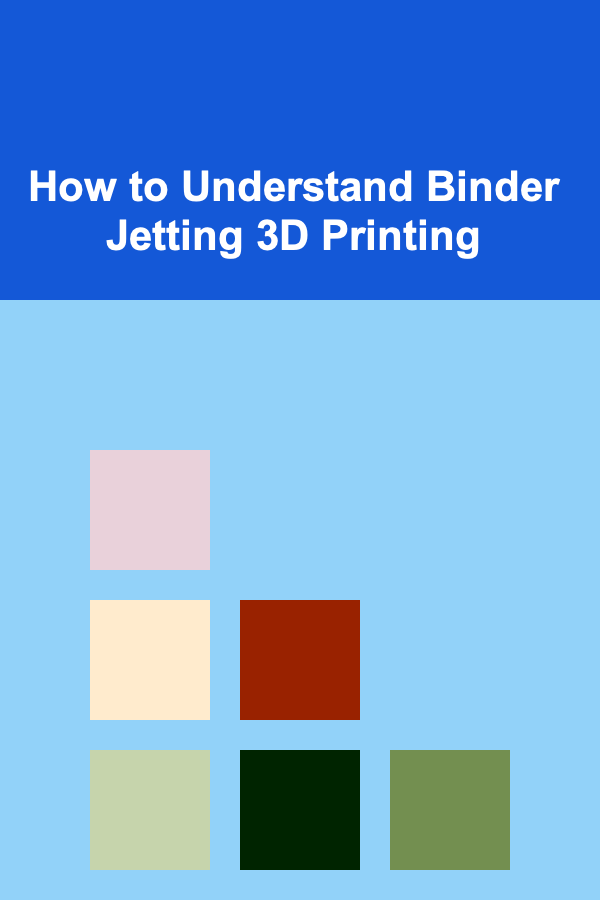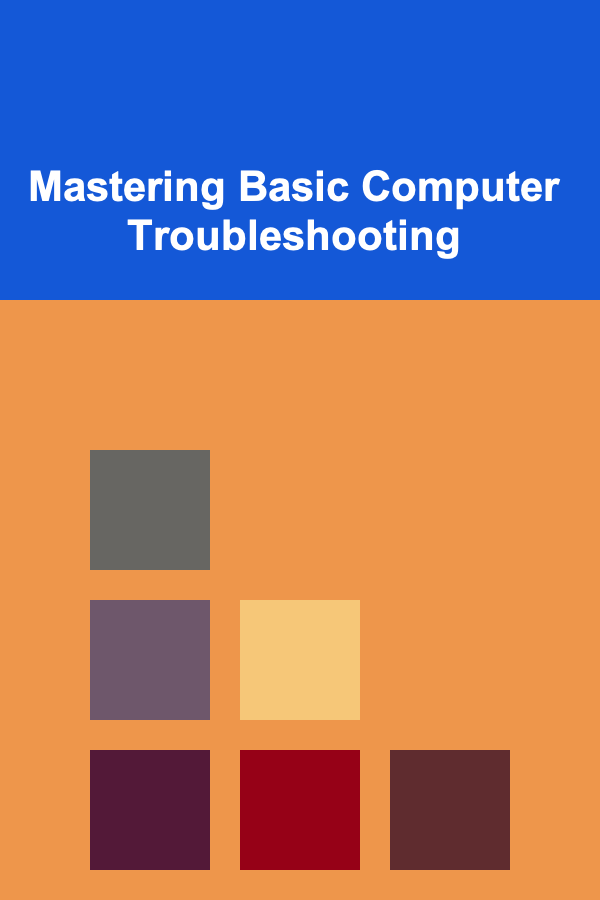
How to Understand Binder Jetting 3D Printing
ebook include PDF & Audio bundle (Micro Guide)
$12.99$6.99
Limited Time Offer! Order within the next:

3D printing has revolutionized the world of manufacturing, bringing new possibilities to industries ranging from aerospace to healthcare. Among the various 3D printing technologies, binder jetting is a process that has garnered attention for its ability to produce high-quality, complex parts quickly and efficiently. While less commonly known compared to methods like Fused Deposition Modeling (FDM) or Selective Laser Sintering (SLS), binder jetting has proven to be a game-changer in several applications.
In this article, we will delve deep into the mechanics of binder jetting, explore its advantages and disadvantages, and discuss its potential future impact. By the end, you will have a solid understanding of how this 3D printing technology works and its role in advancing manufacturing processes.
What Is Binder Jetting?
Binder jetting is an additive manufacturing technique where a liquid binder is selectively deposited onto a powdered material to create solid parts. It is a multi-step process that involves building a part layer by layer, using a powder bed and a binder to bind the powder particles together.
The key differentiator of binder jetting, compared to other 3D printing techniques, is its use of a liquid binder instead of fusing the material using heat or a laser. The material can be metal, ceramic, or sand, making binder jetting incredibly versatile.
The Basic Steps of Binder Jetting
- Powder Layering: A thin layer of powder is spread evenly over the build platform.
- Binder Jetting: The print head moves across the platform, depositing the binder material in specific areas, which binds the powder particles together in those locations.
- Layering: After the binder is applied, a new layer of powder is added to the build platform, and the process is repeated. This continues until the entire part is built.
- Post-Processing: Once the part is complete, it is removed from the powder bed and undergoes post-processing steps such as curing or sintering (for metal parts) to solidify the part completely.
Types of Materials Used in Binder Jetting
One of the main reasons binder jetting stands out is its compatibility with a variety of materials. The powder used in the process can be metal, ceramic, or sand, allowing binder jetting to serve a broad range of industries.
1. Metal Powder:
Metal parts produced by binder jetting are often used in industries such as aerospace, automotive, and medical devices. Materials like stainless steel, aluminum, and titanium are commonly used. After the binder is deposited, the part is sintered in a furnace to fuse the metal particles together and produce a fully solid part.
2. Ceramic Powder:
Binder jetting can also be used to produce ceramic parts. Ceramic parts made using this method are often used in applications like heat-resistant components, medical implants, and dental products. Post-processing typically involves firing the parts at high temperatures to fully sinter the ceramic material.
3. Sand:
Sand is frequently used in the construction of molds for casting in industries like metal foundries. In this application, binder jetting is used to produce precise, custom molds, which can then be used in traditional metal casting processes.
4. Composite Materials:
Composite powders, which are mixtures of different materials (like metal and polymer), can also be used. These materials have the potential to offer unique properties like enhanced strength, flexibility, or thermal resistance.
Advantages of Binder Jetting
Binder jetting has numerous advantages that make it an attractive 3D printing technology for various industries. Some of the key benefits include:
1. High-Speed Printing:
Compared to other 3D printing techniques, binder jetting offers rapid build speeds. Because it doesn't require heat or a laser to fuse the material, the process can produce parts much faster than technologies like SLS or SLA. This makes it ideal for creating large batches of parts quickly.
2. Wide Material Options:
Binder jetting is one of the most versatile 3D printing technologies when it comes to material choices. Whether it's metals, ceramics, or sand, the ability to print with a wide variety of powders means that binder jetting is applicable across many different industries, from aerospace to jewelry.
3. Cost-Effective for Large Parts:
For applications requiring large-scale parts, binder jetting can be more cost-effective than other 3D printing technologies. The use of powder beds allows for efficient material use, and the absence of expensive lasers or heated print beds makes the overall cost of operation lower.
4. No Need for Support Structures:
Unlike methods such as FDM or SLA, which often require support structures to prevent parts from warping or collapsing, binder jetting doesn't need these supports. Since the powder bed itself provides structural support during the printing process, there are fewer concerns about geometry-related issues during production.
5. Complex Geometries:
Binder jetting is capable of producing highly complex geometries that would be difficult or impossible to create using traditional manufacturing methods. This is because the process allows for intricate layering and fine control over material placement, making it suitable for prototyping and end-use applications that demand precision.
Disadvantages of Binder Jetting
Despite its many advantages, binder jetting also has its limitations. Some of the challenges include:
1. Post-Processing Requirements:
The binder jetting process often requires extensive post-processing to ensure that the parts are fully solidified and meet the desired mechanical properties. For metal parts, this may involve sintering or heat treatment, while ceramics and sand molds need additional firing steps. This adds time and complexity to the overall production process.
2. Material Properties:
While binder jetting can produce parts with good surface detail and accuracy, the material properties of the final product can sometimes be inferior to those produced by other methods, such as selective laser sintering. For example, metal parts may not be as strong until they undergo sintering, and ceramic parts may have reduced fracture toughness compared to those made using traditional ceramic manufacturing methods.
3. Limited Build Volume:
Although binder jetting is fast and cost-effective, the build volume can be somewhat limited compared to other technologies like SLS. This means that for very large parts, multiple smaller parts may need to be printed and assembled later.
4. Binder Residue:
The liquid binder used in the process can sometimes result in unwanted residues or imperfections in the finished part. These residues need to be carefully managed during post-processing, or they may affect the quality or performance of the part.
Applications of Binder Jetting
Binder jetting is an incredibly versatile technology, with applications spanning across a range of industries. Some of the most notable uses include:
1. Prototyping:
Binder jetting is frequently used for rapid prototyping, especially for industries like aerospace, automotive, and medical devices. The ability to create functional prototypes with complex geometries allows designers and engineers to iterate on their designs quickly and efficiently.
2. Sand Casting Molds:
One of the most well-established applications of binder jetting is in the creation of sand molds for casting. In industries such as metal casting, binder jetting allows for the creation of custom, intricate molds without the need for expensive tooling or lengthy setup times.
3. Metal Parts for Aerospace and Automotive:
The aerospace and automotive industries benefit greatly from binder jetting's ability to produce high-performance metal parts. Parts such as turbine blades, engine components, and lightweight structural elements can be created with excellent precision and material properties when combined with post-processing like sintering.
4. Medical Implants:
In the healthcare sector, binder jetting has been used to create personalized medical implants, including dental crowns and orthopedic devices. The precision and material variety of binder jetting make it an excellent choice for producing custom-fit implants that meet the specific needs of patients.
5. End-Use Parts:
With continued advances in material science, binder jetting is increasingly being used to produce end-use parts directly, without the need for any post-processing except for final quality assurance checks. This is particularly true for industries where high customization and low production runs are needed.
The Future of Binder Jetting
As with most 3D printing technologies, binder jetting is continuously evolving. Improvements in material science, faster printing speeds, and better post-processing techniques will likely increase the technology's efficiency and broaden its use in industrial applications.
1. Material Advancements:
The development of new and better materials for binder jetting is a significant area of focus. With more advanced materials, the technology could be used in even more industries, and it could be capable of producing parts with superior strength, flexibility, and durability.
2. Faster Printing:
Ongoing improvements in hardware and software could lead to even faster printing times. The ability to print large parts quickly and efficiently will make binder jetting a viable option for mass production.
3. More Precise Post-Processing:
Better post-processing techniques, such as more accurate sintering or curing methods, could improve the final material properties of printed parts. This would address some of the current limitations of binder jetting, such as strength and surface finish.
Conclusion
Binder jetting is an exciting and versatile 3D printing technology that offers significant advantages in terms of speed, material variety, and cost-effectiveness. Although it does have its limitations, such as post-processing requirements and material properties, its potential applications across various industries, from aerospace to healthcare, make it a crucial player in the future of manufacturing.
With continuous developments in material science and technology, binder jetting is poised to expand its influence and become an essential tool for creating complex, customized parts quickly and efficiently. Whether for prototyping, metal casting, or end-use parts, binder jetting's role in the future of manufacturing is undeniable.

How to Create a Stunning Holiday Entryway That Welcomes Guests
Read More
How to Make Your Home More Inviting with Warm Lighting
Read More
How to Save Space in a Studio Apartment with Clever Layouts
Read More
How To Use Yoga for Joint Health
Read More
How To Program Swarm Robotics for Collective Behavior
Read More
Mastering Basic Computer Troubleshooting
Read MoreOther Products

How to Create a Stunning Holiday Entryway That Welcomes Guests
Read More
How to Make Your Home More Inviting with Warm Lighting
Read More
How to Save Space in a Studio Apartment with Clever Layouts
Read More
How To Use Yoga for Joint Health
Read More
How To Program Swarm Robotics for Collective Behavior
Read More